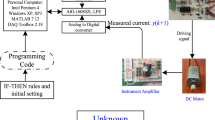Abstract
The fuzzy min–max neural network constitutes a neural architecture that is based on hyperbox fuzzy sets and can be incrementally trained by appropriately adjusting the number of hyperboxes and their corresponding volumes. An extension to this network has been proposed recently, that is based on the notion of random hyperboxes and is suitable for reinforcement learning problems with discrete action space. In this work, we elaborate further on the random hyperbox idea and propose the stochastic fuzzy min–max neural network, where each hyperbox is associated with a stochastic learning automaton. Experimental results using the pole balancing problem indicate that the employment of this model as an action selection network in reinforcement learning schemes leads to superior learning performance compared with the traditional approach where the multilayer perceptron is employed.
Similar content being viewed by others
References
Anderson, C. W.: Strategy learning with multilayer connectionist representations, Technical Report TR87-509.3, GTE Labs, Waltham, MA.
Anderson, C. W.: Learning to control an inverted pendulum using neural networks, IEEE Control Systems Magazine, 2 (1989), 31-37.
Barto, A. G., Sutton, R. S. and Anderson, C. W.: Neuron like elements that can solve difficult control problems, IEEE Trans. on Systems, Man and Cybernetics, 13 (1983), 835-846.
Berenji, H. R. and Khedkar, P.: Learning and tuning fuzzy logic controllers using reinforcements, IEEE Trans. on Neural Networks, 3 (1992), 724-740.
Bigus, J. P.: Data Mining with Neural Networks, McGraw-Hill, (1996).
Kaelbing, L., Littman, M. and Moore, A.: Reinforcement learning: A survey, J. Artificial Intelligence Res., 4 (1996), 237-285.
Kontoravdis, D., Likas, A. and Stafylopatis, A.: Efficient reinforcement learning strategies for the pole balancing problem, In: M. Marinaro and P. Morasso (eds), Proc. ICANN'94, Springer-Verlag, (1994), pp. 659-662.
Likas, A., Blekas, K. and Stafylopatis, A.: Application of the fuzzy min-max neural network classifier to problems with continuous and discrete attributes, In: Proc. IEEE Workshop on Neural Networks for Signal Processing, Ermioni, Greece, (1994), pp. 163-170.
Likas, A. and Blekas, K.: A reinforcement learning approach based on the fuzzy min-max neural network, Neural Processing Letters, 4(3) (1996), 167-172.
Lin, L.: Self-improving reactive agents based on reinforcement learning, planning and teaching, Machine Learning, 8 (1992), 293-321
Lin, C-J. and Lin, C-T.: Reinforcement learning for an ART-based fuzzy adaptive learning control network, IEEE Trans. on Neural Networks, 7 (1996), 709-731.
Narendra, K. S. and Thathachar, M. A.: Learning Automata, Prentice-Hall, (1989).
Simpson, P. K.: Fuzzy min-max neural networks-Part 1: Classification, IEEE Trans. on Neural Networks, 3(5) (1992), 776-786.
Simpson, P. K.: Fuzzy min-max neural networks-Part 2: Clustering, IEEE Trans. on Fuzzy Systems, 1(1) (1993), 32-45.
Sutton, R. and Barto, A.: Reinforcement Learning: An Introduction, MIT Press, (1998).
Author information
Authors and Affiliations
Rights and permissions
About this article
Cite this article
Likas, A. Reinforcement Learning Using the Stochastic Fuzzy Min–Max Neural Network. Neural Processing Letters 13, 213–220 (2001). https://doi.org/10.1023/A:1011344810020
Issue Date:
DOI: https://doi.org/10.1023/A:1011344810020




